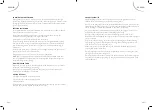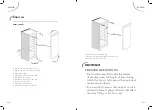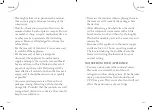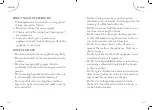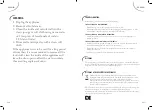
ENGLISH
ENGLISH
GB-11
GB-10
SHOPPING FOR FROZEN FOOD
The appliance is rated as a 4 star freezer and can freeze fresh food and store pre-
frozen food. When you are buying frozen food, look at the Storage Guidelines on the
packaging. You will be able to store each item of frozen food for the period shown
against the 4 star rating.
FREEZING FRESH FOOD
It is recommended to set the thermostat knob to the maximum position in order to
freeze fresh food as quickly as possible.
Ensure that your freezing operations are carried out under the most hygienic
conditions as freezing alone does not improve the food.
Never put hot or even warm foodstuffs into the freezer.
Prior to freezing the food, food should always be covered tightly with foil, plastic
film, placed in plastic bags or stored in airtight containers. This will prevent food
from dehydrating and to prevent any strong odors of some foods transferring to
milder ones.
To freeze raw meat, wrap in plastic bags or in airtight containers and place on the
lowest shelf to avoid cross contamination.
Do not allow raw meat to come into contact with cooked foods.
NOTE: The ambient temperature of the freshly stored food and how often the
door is opened affect the temperature in the refrigerator. If required, change the
thermostat temperature settings.
STORING FROZEN FOOD
All frozen food you purchase should be placed in the freezer as soon as possible to
avoid them from defrosting and spoiling.
All storage recommendations printed on the packaging of frozen food by the
manufacturer should always be followed.
MAKING ICE CUBES
1. Fill the ice tray with ¾ full of clean water.
2. Place the tray in the top freezing drawer.
3. Close the door.
To remove the ice cubes from the tray, put the tray under running water for a while
and then twist the tray slightly to loosen the ice cubes.
ENERGY-SAVING TIPS
Install the fridge or freezer in a cool place out of direct sunlight and away from
cookers, heaters, dishwashers or any hot air emitting items.
Do not set the fridge and freezer temperatures lower than necessary. Set the internal
temperature within the correct range e.g. adjust the thermostat at middle position for
4°C in the fridge compartment and -18°C in the freezer respectively.
Let pre-cooked foods cool down before placing them in the fridge or freezer. This
will prevent the internal temperature of the fridge from rising.
Keep your fridge full, but not over crowded, this helps reduce “cold” air loss.
Meanwhile, avoid overloading the fridge or freezer. Try to leave about 20% free space
for air circulation.
To prevent cold air escaping, limit the frequency of opening door. When retuning
from shopping, sort foods to be kept in your fridge before opening the door. Only
open the door to put food in or take it out.
Make sure the door seal is clean and in good condition. It should hold a piece of
paper tightly in place when shut.
Defrost regularly or when ice is more than 5mm thick. Thick ice covering the inner
sides significantly increases energy use.
The combination of the drawers, baskets and shelves shown in the device description
is optimal for efficient energy savings. Changing the combination proposition could
alter the efficiency.
Содержание K4266
Страница 1: ......















